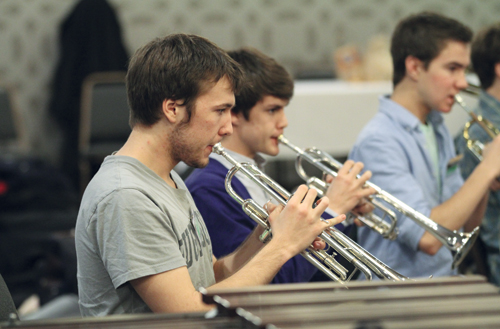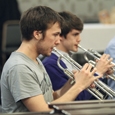
A good sound is a good sound, but the expectation of what a good sound is varies between classical and jazz. Throughout the classical world, a good trumpet sound means something rather specific. A good classical sound is full and even, meaning that it has a good core to it and a full sustain. The volume is the same at the beginning, middle, and end of each note; there is no taper. It shouldn’t be too bright or brassy, but also should avoid being so dark that there are no highs in it. You want to have a ringing quality to the sound that projects, but also a vocal quality.
A wide variety of sounds can be considered acceptable in jazz, but there is no excuse for having poor technique or an inability to play in tune. I have heard people say, “I’m just going to play jazz, so I don’t need to work on my slurs or articulations.” That is complete nonsense. Many of the best jazz players who ever lived had fantastic technique and few limitations. No one should ever forget that Miles Davis was a student at Juilliard for at least a semester before he got too famous. Clifford Brown had fantastic technique and a great articulation. As you listen to the best players, it becomes obvious that they all spent a great deal of time practicing. Sean Jones, one of the top jazz trumpeters today, works a great deal on technique.
Listening
In my experience, few young trumpet players know how a trumpet is supposed to sound. They base their sound off of the best trumpet player they’ve heard, who is usually the player sitting first chair in their band. Their entire sound concept is based off of a beginner’s sound.
What I tell my students is that you can only play what you can hear, and the quality of your sound is limited by the quality of your imagination. If you cannot hear or imagine what a good sound is, then there is no chance you will play it. Usually what I will do is demonstrate or play along with younger students so they hear a more advanced sound, or I will give them recordings or tell them to look up someone specific on YouTube. A Maurice André CD can do wonders for a student’s sound.
Listening works because students become more aware of both their sound and the sound that the trumpet can produce. It can be a moment where the light bulb comes on, because inexperienced players may have no idea what the instrument’s capabilities are. I remember the first time I listened to Wynton Marsalis playing the “Carnival of Venice.” I didn’t even know what double tonguing or triple tonguing was at the time. I had listened to Dizzy Gillespie and Maynard Ferguson before, so I had a good idea of some of the things that the trumpet could do, but hearing Wynton play was that moment for me. Hearing great trumpeters inspires students to emulate them.
If you are going to play jazz, you have to listen to it first, especially if you are going to improvise, which is the heart of what jazz is. To improvise is to speak a language, which means you need a vocabulary. You need to know the scales and understand what the chord symbols mean and what scales, chords, and tonalities they represent. You have to work on your accent, so to speak, just as if you were learning Spanish. The letters in “Hola, me llamo Josh,” represent different sounds in Spanish than they do in English. If you don’t say something the right way, it doesn’t mean anything. The best thing to do when learning a language is listen and repeat. In jazz, this can mean playing along with albums, transcribing, or finding a great player or teacher and playing along with them.
Going to concerts is important, too. I go out to hear concerts as often as possible, because hearing new sounds and musical ideas is vital to our development as musicians. I encourage all my students and their parents to go to concerts. This can go a long way to motivate students. Plus, musicians should support each other.
Singing
Singing is extremely important for both jazz and classical playing. You have to be able to hear in your mind what you want to play, because you cannot expect to be able to play something you cannot hear, you cannot hear something if you have never imagined it, and you cannot imagine something you have never thought about. A good sound, good phrasing, and good intonation do not happen by accident.
I will have my students sing their music, buzz it, then play it. Singing and buzzing help students develop a lyrical quality and a better sense of pitch; it also forces you to first hear the notes in your head. The trumpet forces the player to the nearest partial, making it possible to cheat, but when buzzing or singing no such help is available. Students must hear the pitches correctly and sing or buzz them properly. Learning how to sing and buzz accurately is going to improve the trumpet sound because students will buzz with more accuracy and not depend on the trumpet to funnel them into the right note.
Singing can make students uncomfortable, but it helps to remove the distractions an instrument can cause to inexperienced players, who are often extremely focused on the mechanics of the instrument – or even just holding it. Singing is a good way to remind students that this is just music and the most important thing is the melody. It will really help them to produce more musical phrases while singing or buzzing, which should translate back to the trumpet.
It took me a while to understand and appreciate my first jazz lessons when I attended Oberlin. I was getting both a jazz and a classical degree, so I had two lessons a week. In my jazz lessons I studied with Kenny Davis. He assigned me songs to play, but we weren’t working on improvisation very much; we would just play through the melodies together. Davis has played in the Ellington Band and with such people as Stevie Wonder and Aretha Franklin. You don’t get gigs like that without being able to improvise, but in our lessons, we mainly just played through melodies. I remember asking whether we should solo over some of them, but he responded, “Oh, no, let’s just play some more melodies.” What he was showing me was the importance of playing the melody. If you go to a jam session, some people won’t know the melody. They know the chords and can solo over them, but the improvisation is supposed to be an answer to the melody. Melody is important, because it is what people are drawn to, and the improvisation is what you play that is influenced and informed by the original song. If you don’t know the original song, how can you hope to improvise off of it?
Buzzing
I teach sustain through buzzing. When you buzz you have to move air the whole time, which means you are using a substantial amount of air. If you ask students to play and hold a note, most will say they can do it, but you can’t actually hold a note, you can only sustain it. The difference between the two is that I can hold my phone and it won’t go anywhere, but a note is something that is created and instantaneous. If you hear someone play a note, and a moment later you hear the same pitch at the same volume, then it sounds like the same note, but really every single moment that person is playing is a new note. There is new air going through the lips, and a new vibration. A sustained note is actually a series of new notes that are being created rapidly, which produces the idea and image of sustain.
Buzzing teaches young trumpet players that they are not playing and holding a note, but rather continually creating the note. This gets students to understand how much air they need to use. You cannot just start a note and let it glide; the air has to be steady and uninterrupted. I usually use the analogy of a light bulb. When we turn a light on, the room looks lit up. This is not because the bulb emitted light and the light stuck everywhere, it is just that every moment light is shooting out of the bulb, constantly reilluminating the room. To our eyes it just looks like the room is lit up, but every moment it is brand new light.
Buzzing also helps students develop their breathing. To be done correctly, buzzing must be caused by air, not tension. The buzz is the reaction of the lips to the air. It is not forcing the lips into position that creates a buzz. If you’re buzzing on your mouthpiece and you’re relaxed and playing with full air, then it will help the embouchure as well.
Time and Articulation
After sound quality, articulation is the next most important aspect of playing the trumpet. Articulation is the beginning of the note, and when you play in an ensemble with 20, 50, or 100 people, there is an expectation of uniformity of articulation. If you think about how many beginnings of notes there are in a piece of music, it becomes immediately evident how important articulation is. The goal in an ensemble is to avoid scattershot articulations where everyone comes in at a slightly different time.
To get everyone in at the same time, students should count before they play and then breathe in tempo. This is as important as a golfer’s back swing. You can describe different tempos by comparing the back swing used with a driver to that used with a putter. If you play in an extremely fast tempo, you might breathe for two or three beats instead of just one, because one beat would be too little to get a full, relaxed breath. I always tell students to breathe in tempo, because if articulations, which are the air at the beginnings of notes, are to be the same every time, the immediately preceeding step, the breath, has to be the same every time as well. Additionally, if we breathe in tempo that means we will be counting the measure before our entrance, giving us a stronger sense of time. This helps students see how every aspect of playing an instrument ties together.
When discussing articulation with my students, I ask what produces the articulation, and they usually say the tongue. I then ask how the tongue creates the articulation, which stumps them. I then show them how it is only the air that creates the articulation. If air creates a note, and articulation is the start of a note, then air creates articulation. The tongue can’t produce a pitch. Ultimately, every part of the body and the instrument all interact with or affect the air, but only air creates sound.
I tell students the quality of the air is what determines the quality of the articulation, and have students visualize how the air moves. If you want a crisp articulation, you need crisp air. If you want a legato articulation, you need legato air. If you want an accented articulation, you need accented air. Terms like these are concepts students can grasp.
Once students understand these ideas we can start working on articulation studies through scales or Clarke studies. I like to kill two birds with one stone; learning scales while practicing articulations is simply more efficient. Why practice two things separately when you can combine them? When I practice scales and articulations, I usually change modes so I am playing something different ascending and descending, to cover twice as many scales. I also mix up articulations and slurs on the scales. With some planning, practice can become a lot more efficient.
In my jazz lessons, what we were working on while learning these melodies was phrasing, time, and a solid swing feel. Time is what makes jazz what it is. You can play the best notes and greatest licks, but with a poor sense of time it won’t sound good at all. Students learn the importance of time by playing through tunes with other musicians. This is how to best demonstrate the ideas and concepts of jazz time. Students will listen to others play and pick it up.
When switching between classical and jazz, attention must be given to beat emphasis. In jazz beats two and four are strong and the eighth notes are swung, but this is the opposite of classical, in which the downbeat is the strongest, with the third beat (in 44 time) important to a lesser degree with the eighth notes being played evenly. In classical music, notes on beat one get more weight, but if you do that in jazz it will be phrased incorrectly. Even if a note is written on the downbeat, it should be played less strongly than the note on beat two. Most of the music people hear over the radio growing up has strong downbeats; this style is programmed into our brains, so it can be difficult for students to think about time differently at first.
Inexperienced jazz players may overlook the importance of listening to the bass player. The bassist will give you both the time and the harmony. The drumset keeps time as well and is ideal for showing the feel and emphasis of the beats, but the bass gives both the time and the harmony on every beat.
Expectations for articulations are also different. In classical music, trumpet players should have an extremely uniform articulation, whether they are playing in band or orchestra or soloistically. In jazz, articulations vary; certain notes are accented, and some notes might be leaned into. For the most part jazz articulations are a lot more legato; trying to swing heavily tongued notes sounds strange. They are also a lot lighter, and the note blooms slightly late. This all goes back to singing. Students should sing their music and then play it the way they sang it.
Technique
The technical expectations of a jazz player compared to a classical player are different. In classical trumpet music at a high school or college level, a trumpet player would not be expected to play higher than written D6 or E6. In jazz, the expectation would be G6 or higher. In college I played lead trumpet on an arrangement of Recorda Me that went up to A6 or B6. The expectations when playing that high are different in classical and jazz. When playing that high in a jazz setting, the sound and articulation expectation is that you peel some paint off the back of the room. The great lead trumpet players play notes like that with a degree of finesse, but if someone writes a G6 in a lead trumpet part, the expectation is that it be heard. In classical music, something like the Brandenburg Concerto No. 2 is extremely high, but it is usually played on a piccolo trumpet and is supposed to be played delicately. Even if a classical trumpet part has a written high D or E, most players will switch from a Bb trumpet to one in C or Eb, if not a piccolo trumpet.
Interpretation
Another important aspect of playing classical music is following the instructions. Being a great musician means taking all your talent, technique, and hard work and using it to interpret the instructions in the music. Composers spend a great deal of time translating what’s on their minds onto a sheet of paper filled with dots, lines, and letters. This is the blueprint. For some reason, it is taught that notes and rhythms are important but articulations and dynamics are an afterthought. However, these are just as important as the notes themselves. If you have a note that is supposed to be forte and you play it piano, you have totally missed the idea. Paying very careful attention to all the markings and style is important. The right note at the wrong dynamic is the wrong note, just as fingering low D with first and third valve but without kicking the tuning slide out is the wrong fingering. All the parts have to be there.
I ask my students, “Based on how you just played, if you were sitting in the audience would you have been able to fill in where all the dynamics and articulations should have gone?” They say no every time. A characteristic of great performers is being extremely deliberate with the markings. I want my students to get to the point at which if they play a note and it is in time but articulated incorrectly, they say that they played it incorrectly. Paying close attention to the little details is what makes the music come alive. If the articulations and markings were unimportant, the composer wouldn’t have written them in the music.
Equipment
For a student who practices less than 90 minutes a day, equipment isn’t going to be a game changer. I compare it to running: If you run one mile a day, it doesn’t matter how great your shoes are, but if you run a marathon, you need good shoes to protect your feet. Students who practice only a little bit will never ever reach the limitations of their equipment; to reach the limitations of your equipment will take a lot of practice. Otherwise, new equipment will mainly have a placebo effect. If a child gets a new mouthpiece or trumpet it will encourage him to practice a lot more. He will think the sound is better because of the new instrument when really it’s because he has been playing the new instrument an hour or two a day. If you gave a student in this scenario back his old trumpet, he would probably sound just as good. All the big music companies make great introductory model horns. You cannot go wrong with any of them.
Students have to have a working horn with functional valves and slides. I will have a student show up with the ring broken off of the slide, and it has been taped back on. I tell students not to come back until they get it fixed, and I call parents to tell them that the instrument is broken and has to be repaired.
Practice
For practice time, assuming that time spent listening is separate, I would break down a half-hour session for a middle school or high school trumpet player into three chunks. Chunk one, for ten minutes, is spent on warmups and technique. This includes time spent breathing, buzzing, and playing things like long tones and slurs. What most people call lip slurs I like to call air slurs. The air is what produces the note change, not the lips. The second ten minutes should be spent working on classical music. This could be band music, solos, an etude, or duets.
The last ten minutes would be either their jazz band music, working on learning a jazz solo, transcribing, or even spending more time on technique, such as scales. Students can take the materials they worked on at the beginning of the practice session and play them with a jazz feel, rhythm, and articulation. If you think through the exercises students are assigned to do, you can cover a lot of bases using fewer studies and exercises. You can repurpose music by changing it from a classical to a jazz feel. This final section could also be spent learning some basic theory, like a blues scale or modes. This keeps practice sessions simple: three parts equally divided between warmups, classical, and jazz.
I add piano playing to my practice sessions and am a big proponent of all jazz musicians knowing how to play the piano. The trumpet is a single-voice instrument that cannot play both melody and harmony, so advanced students should at least learn how to play the chords on the piano so they can hear how the chords sound and see how the voicings move.
We are used to playing on our own in practice, but often the purpose of practice is to prepare ourselves to play with a group, whether that is in band or orchestra or with a pianist. If we keep this idea in mind during individual practice sessions, it will make ensemble rehearsals smoother and performances more musical with a better ensemble sound. We all want to play together and have fun, and I find that the better players get, the more fun they have.






